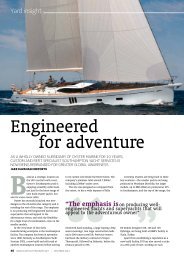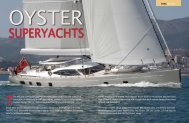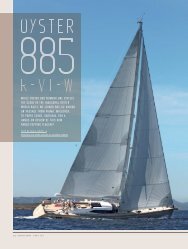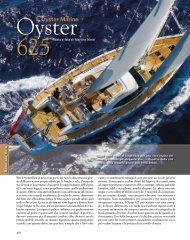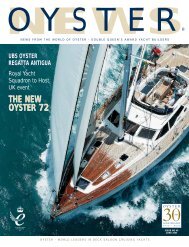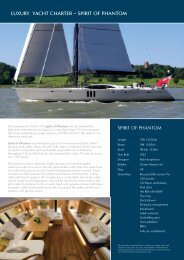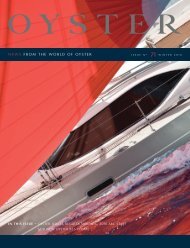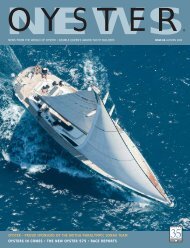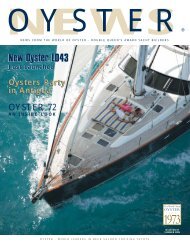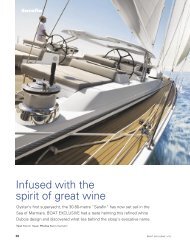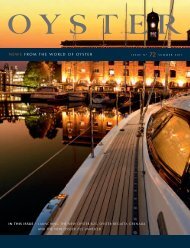Create successful ePaper yourself
Turn your PDF publications into a flip-book with our unique Google optimized e-Paper software.
On tour in Sao Nicolau<br />
Local house, Sao Nicolua<br />
Local hazard<br />
of sometimes fierce acceleration zones around<br />
the ends of them and equally the extensive<br />
wind shadows in the lee of the high<br />
mountains. Having said that, gales are rare in<br />
the normal cruising season and we<br />
experienced more calms than stronger<br />
breezes when in close proximity to the islands.<br />
We soon fell in love with Sao Nicolau. Tarrafal<br />
is a poor fishing port sheltering beneath<br />
fierce-looking bluffs of sun-scorched red rock<br />
stretching up towards the central mountains.<br />
However, a spectacular cobbled road wound<br />
up into the hills from here into the verdant<br />
central crater and down into the main town of<br />
Ribeira Brava. Like most roads in these<br />
islands, it had been paved with tiny cobbles,<br />
each one lovingly cut by hand from nearby<br />
rock and painstakingly slotted into place.<br />
Even the ‘white lines’ had been set using<br />
lighter-coloured stones. In Tarrafal, we were<br />
soon taken in hand by ‘Henny’, a Dutch excruising<br />
sailor who had decided to settle in<br />
this remote place in a brightly-painted house<br />
with a retinue of local boys. Henny acted as<br />
our guide for a gruelling but very enjoyable<br />
day-long tour of the island in a charted<br />
aluguier, bumping along endless serpentine<br />
mountain roads up and down mountain<br />
valleys under the hot sun. The interior of the<br />
island was split by spectacular jagged<br />
mountain ridges between which nestled<br />
fertile craters and tiny verdant valleys. These<br />
fertile patches were intensely farmed for<br />
maize and sugar cane, but the small thatched<br />
stone houses revealed a tough struggle to<br />
live here and most domestic water had to be<br />
fetched from wells by women and children<br />
carrying huge buckets on their heads. Many<br />
houses and some whole villages had been<br />
abandoned altogether in the constant<br />
struggle for survival. Most of the houses and<br />
a number of the villages were accessible only<br />
by cobbled donkey trails and these provided<br />
opportunities for tremendous, if strenuous,<br />
walks around the island, using the passing<br />
aluguiers to travel to and from points<br />
along the way. We had amazing<br />
walks from Tarrafal to Hortelao<br />
and from Faja de Cima to<br />
Estancia de Bras via<br />
Covada and Ribeira<br />
Funda. A further<br />
unexpected treat here<br />
was the opportunity<br />
to watch the<br />
England versus<br />
Australia World<br />
Rugby finals on TV.<br />
A completely<br />
bemused, but cable-<br />
TV owning local bar<br />
owner, was persuaded<br />
to open early one morning to allow the crew<br />
of the two British boats present to cluster<br />
around the bar for the occasion, the final<br />
touch being (after a considerable amount of<br />
imaginative sign-language) the serving of<br />
eggs and bacon at half-time!<br />
We had been warned about Mindelo as being<br />
a den of thieves and pickpockets, to be<br />
avoided if possible. In fact, it was our<br />
favourite large town of the islands with a<br />
certain faded, but raffish, colonial charm. We<br />
certainly found it no more threatening than<br />
many a town in the Caribbean. Local boat<br />
boys jostled to mind our dinghy for a small<br />
consideration and another youth rowed out to<br />
offer his services as our ‘agent’ – and did in<br />
fact considerably expedit our port clearance<br />
process as well as help us to re-fill our gas<br />
bottle, all for a few escudos. The town is an<br />
exotic mix of former colonial elegance with<br />
more recent West African influences.<br />
Crumbling but brightly-painted 17th Century<br />
buildings line the streets filled with noisy<br />
vegetable markets, fish markets and street<br />
traders. Hard-core gamblers gather under the<br />
shady trees near the market to play serious<br />
games of cards and dice. At night many of<br />
the bars and restaurants feature live Cape<br />
Verdian music. Sao Vicente island itself has<br />
little of interest, but is close to the island of<br />
Santo Antao which is famous for its scenery<br />
and walking opportunities, although lack of<br />
any available anchorage ruled out a visit for<br />
us. Mindelo was undoubtedly the most<br />
popular with other cruisers and more than 50<br />
yachts lay in the huge and very well-sheltered<br />
harbour, nearly all making a pit stop en route<br />
for the Caribbean. The ‘Club Nautico’ bar<br />
near the dinghy dock was a popular and<br />
multi-cultural meeting point for the many<br />
cruising folk in town.<br />
Mindelo certainly scored more highly for us<br />
than Praia, the official capital of the islands on<br />
Santiago. Although similar in many ways to<br />
Mindelo, with its colonial centre perched high<br />
on a bluff over the harbour, the city had a<br />
more aggressive edge to it which made us<br />
feel less comfortable there. The harbour too<br />
was much less protected and a large swell<br />
rolled in continuously. Ominously, several<br />
large wrecks decorated the margins of the<br />
harbour. We were much more taken by the<br />
ruins of the old city, Cicade Velha, a few miles<br />
away on the coast. This had been the original<br />
site of the city before it was abandoned in the<br />
face of constant assaults by Sir Francis Drake<br />
and other official pirates of his age. These<br />
days the restored ruins of the cathedral and a<br />
mighty hilltop fort dominate only a small<br />
fishing village outside which we anchored<br />
precariously for the afternoon.<br />
www.oystermarine.com 25




